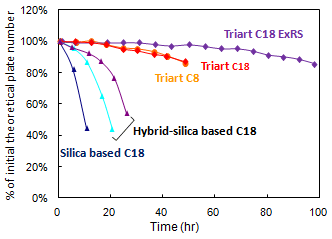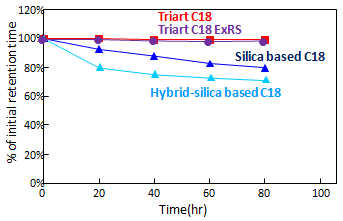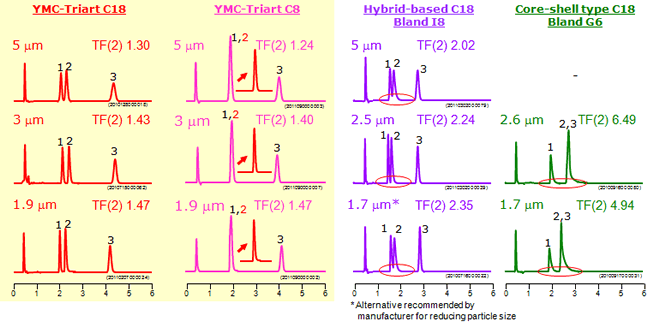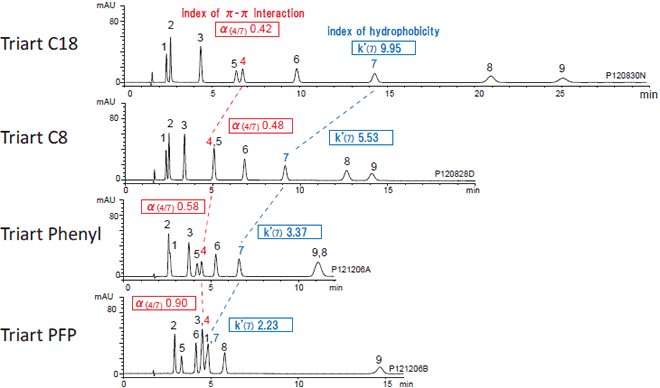With innovative surface modification on organic hybrid silica, YMC-Triart columns show great chemical durability and can be used over a wide pH range. Even at high-pH or high-temperature conditions, the lifetimes of YMC-Triart C18 and C8 are more than 10 times greater than those of conventional C18 columns and a few times greater than those of commercially available high-alkaline-resistant C18 columns.
Durability at a high pH
pH 11.5, 40ºC

| Column | 5 µm, 150 X 4.6 mmI.D. |
|---|---|
| Eluent | 50 mM K2HPO4-K3PO4 (pH 11.5)/methanol (90/10) |
| Flow rate | 1.0 mL/min |
| Temperature | 40ºC |
| Sample | benzyl alcohol |
Durability at a low pH at a high temperature
pH 1, 70ºC

The columns are kept in acetonitrile/water/TFA (10/90/1, pH 1) at 70ºC, and tested for performance every 20 hours under the condition of column inspection below.
| Column inspection | |
|---|---|
| Column | 5 µm, 50 X 2.0 mmI.D. |
| Eluent | acetonitrile/water (60/40) |
| Flow rate | 0.2 mL/min |
| Temperature | 37ºC |
| Sample | butyl benzoate |
The peak tailing or fronting of ionic compounds is often caused by adsorption to residual silanol groups and/or surface impurities resulting from the base material or manufacturing processes.
YMC-Triart, based on a hybrid silica material with low metal impurities and rigorously endcapped, provides symmetrical peak shapes for all types of compounds.

| Eluent | 20 mM KH2PO4-K2HPO4 (pH 6.9) /acetonitrile (65/35) |
|---|---|
| Detection | UV at 235 nm |
| Sample | 1. Chlorpheniramine 2. Dextromethorphan 3. Propyl paraben (I.S.) |
| Eluent | acetonitrile/0.1% H3PO4 (40/60) |
|---|---|
| Detection | UV at 254 nm |
| Sample | 1. Hinokitiol 2. Methyl benzoate (I.S.) |
| Eluent | 10 mM CH3COOH-CH3COONH4 (pH 4.2) /acetonitrile (75/25) |
|---|---|
| Detection | UV at 254 nm |
| Sample | 1. Salicylic acid 2. Methyl paraben (I.S.) 3. Cinnamic acid |
| Column | 150 X 3.0 mmI.D. or 150 X 4.6 mmI.D. |
|---|---|
| Flow rate | 0.425 mL/min for 3.0 mmI.D., 1.0 mL/min for 4.6 mmI.D. |
| Temperature | 40ºC |
YMC-Triart columns have identical selectivity and excellent peak shapes for basic (ionic) compounds across all particle sizes, including 1.9 μm. This allows predictable scale-up from UHPLC to conventional HPLC and even to semi-preparative LC, and vice versa. In contrast, commercially available C18 columns often show some differences in selectivity, retention, and peak shape between different particle sizes.
Basic compounds

| Column | 50 X 2.0 mmI.D. or 2.1 mmI.D. |
|---|---|
| Eluent | 20 mM KH2PO4-K2HPO4 (pH 6.9)/acetonitrile (65/35) |
| Flow rate | 0.2 mL/min |
| Temperature | 40℃ |
| Detection | UV at 235 nm |
A mixture that consists of compounds with various characteristics is analyzed with reversed-phase Triart columns. In addition to hydrophobic interactions, secondary interactions such as π–π interactions and polar interactions differ from column to column. These parameters have a great impact on the retention capacity (k′) and separation factor (α). By utilizing the differences in the separation characteristics, a wide range of compounds can be well separated with Triart columns.

| Column | 5 µm, 150 X 3.0 mmI.D. |
|---|---|
| Eluent | 20 mM KH2PO4-H3PO4 (pH 3.1)/methanol (25/75) |
| Flow rate | 0.425 mL/min |
| Temperature | 40℃ |
| Detection | UV at 265 nm |
| Injection | 4 µL |